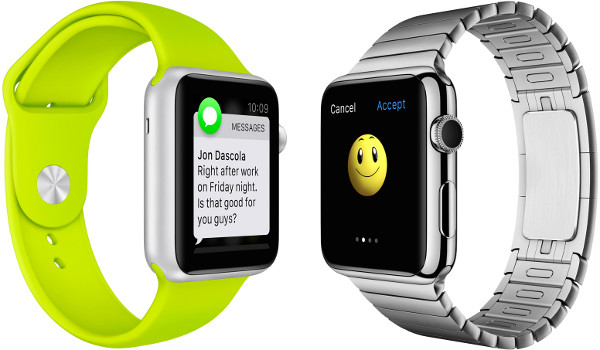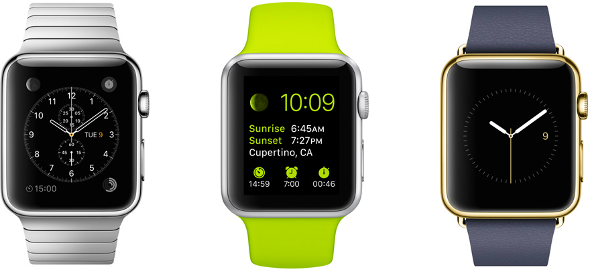Will Apple Watch Wear Smartwatch Crown?
We've finally set eyes on the much-anticipated Apple Watch. I wore it in a controlled setting — so controlled that I couldn't interact with it. In other words, I was asked to marvel at it. And I did. The Apple Watch represents distinct, compelling steps forward for this nascent technology category — steps that, once again, Apple proved only it can make. [A hands-on video from Apple's event is embedded below.]
As exciting as it was, I was left wanting more. For one thing, the Apple Watch is still probably six months away. For another, it will still be tethered to a phone (and specifically an iPhone 6 or iPhone 5). To top it all off, it will cost $349 just for the least expensive model. In hindsight, I guess I'm not all that surprised.
But none of this will deter the Apple faithful, the first movers, the hip, the rich. (Will those who follow Apple still be called Apple watchers?) The Apple Watch will do gangbusters, if for no other reason than it's Apple. Love or hate Apple, the company doesn't just rush a product to market without a few attempts at creating something iconic.
The most obvious example in the Apple Watch is the digital crown, a user interface so obvious and simple, watching it in use made me feel stupid for forgetting about it. Scrolling through notifications or within an app, zooming in and out, even pressing it as a home button all seemed pretty obvious.
The device changes from a watch to a phone peripheral by sensing that you're looking at it. There is subtle haptic feedback (via linear actuator — Apple calls this its "taptic" engine) when getting a notification. You can input with a touch, but the watch can sense force, so it can detect a tap versus a press. You can send quick, fun messages using the watch face as a drawing board. You can even send your heartbeat to another user.
The watch's 38mm face (42mm for the bigger versions) has a retina display, protected with a Sapphire lamination. The watch supports Siri in addition to typical swipe gestures and the digital crown UI.
Oh yes, Apple intends to make the Apple Watch the ultimate fitness device, too, detecting your pulse, but also tracking daily activity, helping you establish milestones and view them throughout the day.
Get Tom's Hardware's best news and in-depth reviews, straight to your inbox.
And I haven't even talked about the choices — choices in size and style, from the strap to the face of the watch body, including 18-karat gold. There's no telling what Apple's legion of developers will do with Watchkit, the new SDK for Apple Watch apps. Apple showed off customized versions of Twitter, American Airlines (check in from your watch), and Starwood Hotels (you can not only check in, but you will be able to unlock your room door by waving your watch in all W Hotels by next Spring). Control lights in your home, your Apple TV and so on. Like the iPhone 6, the Apple Watch will make payments using NFC.
With Apple's S1 chip for the Apple Watch, along with the normal assortment of gyros and accelerometers, and using the GPS and Wi-Fi from an iPhone, the roads are certainly being paved. If the smartwatch industry moves as fast as the smartphone market did, we'll have it all baked-in in short order.
Until then, the Apple Watch will remain simply the most compelling accessory to an iPhone ever created, and that's where I still grapple with the smartwatch, no matter what bells and whistles are included: it still seems like it solves a need that doesn't quite exist. But then again, isn't that where Apple truly thrives? Tell me: Will you be lining up to buy the Apple Watch?
-
BlasterX The watch looks bulky as hell like a kid's watch. Even the Asus Zenwatch looks better in this case with the brown leather band.Reply
-
soldier44 I stopped wearing watches in the 90s, this basically takes all that your cell phone does away. No thanks.Reply -
velocityg4 With there douchebag move of putting 16GB storage in the bottom line iPhone 6 plus and expecting you to pay $750. I couldn't imagine also dropping at least $350 on a watch I'd have to throw out in a couple of years.Reply -
Bloob The UX seems decent, but I don't like the bulkiness of it. Looks like it needs to be strapped pretty tightly for the heartrate sensor to work. Also no mention of battery life and it seems to use iPhone GPS instead of it's own, and yeah, needs an iPhone. The fanboy -reaction of the press during the live event was frankly shameful.Reply
Overall seemed like a decent entry to smartwatch market, but so far none of them appeal to me. -
Nuckles_56 ReplyThe UX seems decent, but I don't like the bulkiness of it. Looks like it needs to be strapped pretty tightly for the heartrate sensor to work. Also no mention of battery life and it seems to use iPhone GPS instead of it's own, and yeah, needs an iPhone. The fanboy -reaction of the press during the live event was frankly shameful.
Without the fanboy reaction, apple launches are nothing
Overall seemed like a decent entry to smartwatch market, but so far none of them appeal to me. -
rwinches Note to presenter; less sales pitch more demo.Reply
Yeah, I can choose a friends picture and send a recorded burp instantly, I'm sure the others in the business meeting, especially the clients, will get a big kick out of it.



